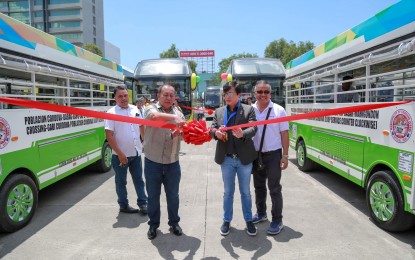
MODERN TRANSPORT. Secretary Michael Lloyd Dino (right), head of the Office of the Presidential Assistant for the Visayas, and Land Transportation Franchising and Regulatory Board Regional Director Edgardo Montealto cut the ceremonial ribbon to mark the roll-out of the 298 modern public utility vehicles (PUVs) in Cebu City on Thursday (July 11, 2019). Dino said the launching of the 'golden age' of the transportation system in Cebu has materialized after President Rodrigo Duterte's promise in his third state of the nation address (SONA) last year to modernize PUV operations in the Philippines. (Photo courtesy of OPAV)
CEBU CITY -- With 10 days more to go before President Rodrigo Duterte delivers his fourth state of the nation address (SONA) on July 22, his top presidential aide in the Visayas led Thursday the rolling out of the “golden age” of Cebu’s transportation system.
In keeping with the Duterte’s promise during his third SONA last year to modernize public transportation, Secretary Michael Lloyd Dino said the Land Transportation and Regulatory Board (LTFRB) in Central Visayas granted provisional authority to operate 298 modern public utility vehicles (PUVs), including 250 taxi units for the region.
Dino, head of the Office of the Presidential Assistant for the Visayas (OPAV), announced the grant of provisional authority during the “Public Utility Vehicles Modernization Program Simultaneous Launch.”
"The President’s PUV modernization program is already long overdue,” Dino said, recalling that its first implementation in the "Yolanda"-hit Tacloban City in 2018 became the springboard for the PUV modernization for the whole country.
Eduardo Montealto, director of LTFRB-7, said 23 P2P (point-to-point) buses will ply three different routes (Cebu City to Sibonga in the south, Cebu City to Lapu-Lapu City in Mactan Island, and Cebu City to Danao City in the north).
Montealto said that 25 electronic jeepneys will serve passengers within the Lapu-Lapu City.
He also said that 75 e-jeepneys are expected to arrive in Cebu before the end of this year. The e-jeeps will have unique features like Wi-Fi, charging ports, fan cooling system, dash cams, cushion seats, and carry 30 passengers each.
P2P buses and modern taxis have an automatic fare collection system, Wi-Fi, speed limiter, GPS tracker, and dashcam, with the buses having its own comfort room, Montealto said.
Aside from the e-jeeps, 87 buses and 50 taxi units are also arriving within the year.
According to Dino, the PUV modernization program started in Tacloban City shortly after he assisted Duterte in visiting the victims of Typhoon Yolanda in 2018.
“We needed to move the typhoon victims to the relocation sites for health and safety reasons but they were hesitant to move because there was still no electricity and the sites were far from the city center,” Dino recalled.
It was during Duterte’s first visit to Tacloban in November of 2016 that the president ordered Dino to move the typhoon victims to the resettlement areas in Tacloban North. Dino said with the help of the Central Command of the Armed Forces of the Philippines and the 53rd Engineering Brigade of the Philippine Army, headed by Col. Edgar Yerro, he was able to accomplish Duterte’s order in less than 20 days.
In 2018, the LTFRB rolled out in Tacloban City 45 units of solar e-jeepneys, equipped with CCTV cameras, dashcams, and automatic fare collection system.
The top presidential aide said the residents of Tacloban City found the system to be effective and way better than their existing means of transportation.
Despite vehement opposition from existing operators and drivers for fear of displacement, the modernization of PUV operations in the country hit a snag.
However, Dino said, “because of the political will of this administration, it made a point to consider all aspects affecting the PUV modernization, thereby addressing the fears of the operators and drivers.,”
In Central Visayas, Montealto conducted a series of stakeholder engagement meetings with the operators and drivers to listen to their plights.
The launching of the modernized transportation system in Cebu has received praise from the netizens. Vinover Janson, a native of Sibonga town and an overseas Filipino worker in Hong Kong, said in her Facebook post that modern PUVs will eventually replace the dilapidated PUVs in Cebu.
Julius Papellero, in his comment to social media post of OPAV, suggested allocating more air-conditioned units to be dispatched from the downtown Colon Street to the interior routes such as the Pit-os in the northern district in this city. (PNA)
